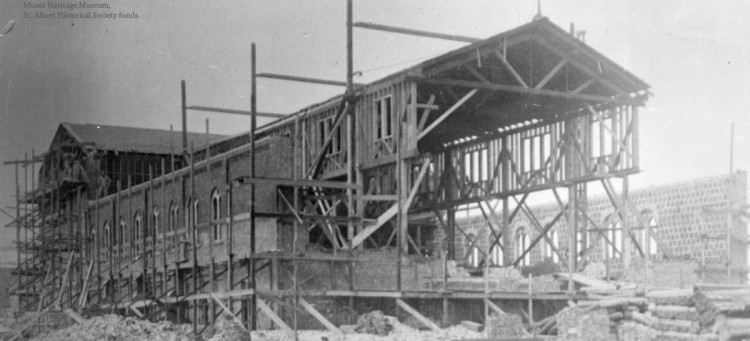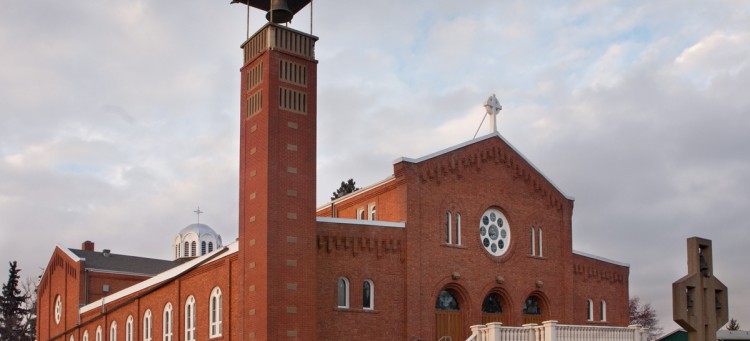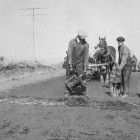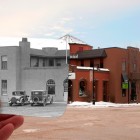Then & Now
Mission
BY DAWN VALENTINE, OF VINTAGE ST. ALBERT
December, 2015
Being St. Albert’s oldest neighbourhood, Mission has a storied past. Ask almost any local, and they’ll share a memory about it. Some will recall skating on the Sturgeon River. Others will remember when the gym at Father Jan School doubled as a movie theatre. Perhaps most common, though, will be stories that include a wipeout—of epic proportions—from sliding down Seven Hills in wintertime. Whatever your ties, to learn the history of Mission is to dig up some facinating facts. Here are a few you may be less familiar with.
1860s
Father Lacombe leaves the Mission at Lac Ste. Anne in search of a more fertile land to sustain the colony.
Father Lacombe and Bishop Taché arrive at the top of the hill above the Sturgeon River and propose a new Mission site.
Father Lacombe Chapel is built in 1861 (It remains the oldest surviving building in Alberta).
The first Métis families arrive from Lac Ste. Anne, establishing St. Albert as a new settlement.
The first bridge across the Sturgeon River is erected in 1862 (and becomes the first permanent bridge west of the Great Lakes).
The Grey Nuns arrive from Lac Ste. Anne with seven orphans in 1863, and the next year a convent housing an orphanage and school is built.
1870s & 80s
Smallpox takes half the population of St.Albert.
The Grey Nuns establish a hospital ward within the convent.
Narcisse Beaudry opens a hotel in 1883, just west of the Mission.
Telephone service to St. Albert is established in 1885.
The Bishop’s Palace is constructed in 1887 (and still stands atop the hill today).
Three bronze bells are donated to the Mission from France.
1890s
St. Albert officially becomes a village.
The Brosseau brothers build a general store in 1892 on the corner of Perron Street and Mission Avenue.
The first fireworks display in Alberta takes place in 1899 atop the hill, celebrating Father Lacombe’s Golden Jubilee.
1900s
St. Albert officially becomes a town in 1904.
The first grain elevator is constructed, and a flour mill is built on the Sturgeon River just below Mill Drive.
Father Mérer School is completed in 1909 on the northwest corner of the hill.
1920s
St. Albert Roman Catholic Church is completed in 1922.
St. Albert Trail is upgraded to highway status.
Mission Park is created, and a poplar-lined Memorial Drive is constructed honouring the veterans of WWI.
1940s & 50s
The residential school at the Youville Convent burns down.
The Chapel of the Immaculate Conception is constructed in 1944 at the bottom of the hill (partly to save heating the big church in winter).
The Little White Schoolhouse (the original Father Jan School) opens in 1948.
The present Father Jan School on Mission Avenue is built and becomes St. Albert’s first high school.
1960s & 70s
Sometime after the demolition of Fater Mérer School, the hill is molded into terraces, creating the renowned Seven Hills.
St. Albert (Catholic) High School is erected in 1967.
The main street is renamed in honour of Fleuri Perron, businessman and mayor.
The Sturgeon General Hospital opens in 1969.
1980s & 90s
In 1984, the steel bridge at Perron Street is replaced by the current bridge.
Founders’ Promenade is established, acknowledging St. Albert’s early settlers.
The Michif Cultural And Resource Institute is formed in the historic Juneau Residence, to foster awareness about the proud history and contribution of the Métis, First Nations and Inuit peoples of Canada.
2000 to Present
The St. Albert Historical Society places a cairn on the site of Father Mérer School.
The expanded Founders’ Walk opens, with nine story panels along the route from the Clock Tower to the top of Mission Hill. t8n
Did You Know? A paddlewheel boat, the St. Theresa, cruised the waters of the Sturgeon River to Big Lake in 1922. The water level soon dropped, and the boat was moved to Lac Ste. Anne.
Photo credit:
Musée Héritage Museum, St. Albert Historical Society fonds, ACCESSION #2003_01_838















